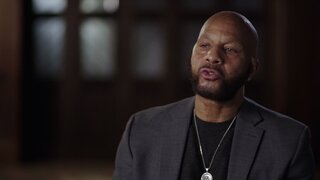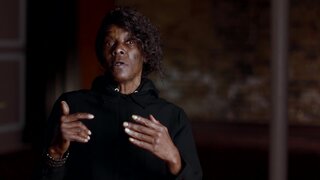Create a free profile to get unlimited access to exclusive videos, breaking news, sweepstakes, and more!
Chicago Serial Killer Brutally Murders 11 Women And Then Steals Their Shoes
Between 1993 and 1998, a Chicago serial killer preyed upon women in the Englewood community.
On September 23, 1993, a building inspector monitoring an abandoned property in Chicago’s South Side made a shocking discovery. He stumbled upon the dead body of a woman on a loading dock and called the police.
The victim was naked from the waist down and had abrasions and defensive wounds on her hands. Investigators were struck by the fact that her face, which had been brutally beaten, was covered by a cloth.
“We definitely made a note of that,” Chicago Police Tactical Unit Officer Anthony Flowers told “Mark of a Serial Killer,” airing on Oxygen.
Investigators also observed that while the rest of the victim’s clothes were at the scene, her shoes were missing. Police suspected that she had been sexually assaulted. The medical examiner, however, found no evidence of rape.
Using fingerprints, police identified the victim as 37-year-old Patricia Dunn, who lived in Englewood. Her loved ones described her to "Mark of a Serial Killer" as “elegant” and “a role model.”
Police combed the area for leads, but they had no witnesses, DNA evidence, or fingerprints left by the assailant. The case went cold and stayed in limbo for two and a half years.
In the spring of 1995, kids exploring an empty house a few blocks from the Dunn crime scene discovered a woman’s dead body. Like Dunn, the victim was nude below the waist, and her face, which had been severely battered, was covered. A cord was wrapped around her neck. Her shoes were missing while her other clothes were in the room.
The “similarities were striking” with the Dunn case, said Chicago Police Department Det. Sergeant Frank Luera.
As police worked the scene, the body was sent to the medical examiner, who determined that the victim had been sexually assaulted. She was also pregnant. She was identified by fingerprints as Angela Shatteen, 36. Despite the fact that DNA had been recovered from her body, the case went cold.
Two years later, on Thanksgiving in 1997, Claudia Robinson, 42, was walking in the same neighborhood and was forced into an abandoned building where was raped and savagely beaten. The perpetrator threw a mattress over her body and took her shoes. Robinson played dead — and survived.
DNA found on Robinson matched genetic material found on Shatteen. As investigators suspected, Robinson’s attack and the 1995 murder were linked. Robinson described her attacker to police as a Black male who was about 6 feet tall.
Robinson helped detectives create a composite sketch of her attacker, which they distributed around the neighborhood. Detectives worked diligently, they told producers, to forge a relationship with locals, including street walkers, gang members, and others. They believed someone out there could have a clue.
Progress on the case was minimal for nine months. Then, on August 13, 1998, police found two women in two abandoned buildings a mile apart. Nicole Thompson, 32, and Evandre Harris, 44, had been beaten, their faces were covered, and their shoes were nowhere to be found.
DNA found on the two victims matched genetic evidence recovered from Robinson and Shatteen.
Police continued to canvas the neighborhood, where they took DNA swabs of men who agreed to give a sample voluntarily. They collected more than 500 DNA samples this way, but there was no match.
Over the course of the next five months, police found two more victims, Cheryl Cross, 38, and Sheryl Johnson, 44. Like the other victims, they were discovered in abandoned buildings, their shoes were missing, and DNA on their bodies matched that found on the other women.
With the murder count at six, the FBI got involved with the case. The community was on high alert. And finally, the bond investigators forged with locals paid off, according to FBI Special Agent Michael Steinbach.
Two women came forward with a tip about a man who went by the name “Dre.” He was known, they said, for getting violent with women in abandoned buildings. Another person told police about a man called Andre who’d get high with sex workers in empty buildings.
Investigators determined that their suspect was Andre Crawford, who was from the area and had been incarcerated for drug and sexual assault arrests. They also found out that he worked occasionally on Chicago Sun-Times distribution trucks.
Police created a timeline of when Crawford was in lockup, and a pattern emerged. When he was behind bars, the murders stopped. When he was out, they started up again. That was an “aha moment,” according to investigators.
Crawford was apprehended on January 28, 2000. Although he initially refused to give a DNA sample, he complied when authorities pointed out that they had a court order.
Crawford told police that he exchanged drugs for sex, according to “Mark of a Serial Killer.” When women betrayed him in any way in this transaction, he became violent. He spent three days confessing to the killings, which included five murders police hadn’t yet linked to this case.
Crawford also admitted that he had sex with the women before and after they were dead.
Police said Crawford routinely sold victims’ shoes he took on an Englewood street corner, reported the Chicago Tribune in 2009.
Dr. John Fabian, a forensic neuropsychologist who evaluated Crawford, found that his mother was negligent and abusive. She prostituted herself and her son when he was 14 years old.
“He wanted to make these women suffer because that’s what he wanted to do to his mother,” theorized Fabian. Covering victims’ faces could indicate shame or regret.
In November 2009, more than 16 years after his first victim was found, Crawford went on trial for 11 counts of murder and one of attempted murder.
He was convicted 2009 after a nearly month-long trial in which his lawyer argued that Crawford suffered childhood sexual abuse and neglect. Jurors spared him the death penalty. He was sentenced to life in prison, where died in March 2017 from liver cancer two days before he would have turned 55.
To learn more about the case, watch “Mark of a Serial Killer” on Oxygen or stream episodes here.



































